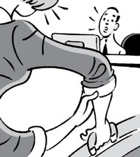
In the midst of everything else that is going on this week at American, frankly, the issue of a ill-conceived lavender colored website “geared towards women travelers” was way down in the middle of the list of issues with American Airlines. It was so not-an-issue that I barely gave it lip service in this week’s PlaneBusiness Banter. To me, it was simply something thrown out there last week in an effort to distract people from what else is going on with the airline.
But thanks to Joe Sharkey with the New York Times, who took up the cause.
In his column dated today, Sharkey writes:
“JULIE PFEFFER, who has traveled on business to more than 55 countries, was among many female business travelers not impressed with the announcement by American Airlines last week that it had started a Web site just for its female travelers, www.AA.com/women.
“There are so many things that are infuriating about this lip-service nonsense that I can’t begin to list them all,” said Ms. Pfeffer, an executive with the emerging markets division of Artisan Partners, an investment management company.
“But I have to ask this: Why does AA feel that female travelers need things explained to them that male travelers don’t? Are we that dumb? That inexperienced in the ways of air travel?” she said.
It seems the airline’s long-planned foray into niche Web marketing for the growing number of female travelers, and especially female business travelers, has “hit a nerve,” as Ms. Pfeffer said.
She was especially disdainful of what she called “stereotyped and occasional downright insulting content” on the Web site, which offers travel advice from a panel of experienced businesswomen, as well as various on-the-road tips and a forum for women to share experiences and compare notes.
Ms. Pfeffer wasn’t buying the airline’s contention that this constitutes vital information. “We most certainly do not need 1950s-era advice, such as ‘Always bring a little black dress to wear with these heels’ — from the ‘Tips From Our Road Warriors’ section — good grief!” she said.
I thought American had a good idea there, mostly because I have always been impressed with the proclivity of female business travelers to network and closely compare notes, in contrast to males. It is an article of faith in the hotel industry that women’s tastes and networking drive decisions on room design, bedding, lighting, even lobby layout.
Airlines, obviously, are not hotels. Airlines have made powerful enemies over the years among both sexes, and a lavender-hued Web site (the color has since been changed) isn’t going to win over a lot of new tough customers, it seems.
Pamela Johnston, the president of the New York public relations company PJ Inc., employs seven female associates, and they all routinely travel first class on company business. No one at her company was exactly overwhelmed by the site.
“There is material out there that already serves women travelers better,” she said. “I don’t see what they brought to the table that was new. It was like, ‘Hi, we have some content that we posted.’ ”
Many of the women who wrote to me about last week’s column noted that they were already networking, on forums and threads devoted to female travelers, like those on the popular Web site Flyertalk.com, and didn’t need what one reader called a “condescending marketing ploy.”
American has sought to tap into the female market with innovations like lie-flat business-class seats on its long-haul flights. The seats have a handy place to stow a purse and privacy screens to make women more comfortable when sleeping.
American posted a statement on Flyertalk.com saying that content on its site “will evolve based on valuable feedback from our customers.” The statement said, “We felt this was an important step in furthering our relationship with our women travelers and demonstrating our continued commitment to the women’s market.”
It added that the airline understood that women, no more or less than men, “want a competitive fare, flight frequency, a large route network, and robust frequent flyer program.”
On Flyertalk.com, some of the reaction was harsh. “I was truly gratified to realize that AA flyers of both genders had the same disgusted reaction that I did to this nonsense,” one post read, suggesting that rather than resorting to “this patronizing silliness,” American should “start paying someone to clean your bathrooms instead of designing dumbed-down lavender Web sites.”
Said another: “As a female frequent traveler for both business and leisure, I’m quite indignant that AA thinks this kind of silly fluff is going to appeal to me. I want a clean plane, a comfortable seat, and good service at a fair price (not cheap, just reasonable). That’s what my husband wants. That’s what my colleagues of both genders want.”
“Instead,” she said, “they offer us dirty planes, wretched seats, and increasingly awful service — sometimes at reasonable prices, sometimes not — and wholly silly programs like this one.”
Added another, “If they’re serious about wanting to do something to make women more likely to fly with them, they should start by cleaning the planes, getting their employees to treat us better, and have someone who understands the human spine (not a good design itself, admittedly) design their seats.”
Some things simply don’t fly the first time up. American says it’s working on this one.”